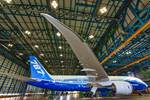EirTrade Aviation undertakes disassembly activities for retiring Boeing 787s
The first two 10-year-old B787-8s to be retired from commercial service will be coordinated and managed in Prestwick, Ireland, with parts expected to be available in late Q1 2023.
Global aviation asset management and trading company EirTrade Aviation (Dublin, Ireland) will manage the disassembly and consignment of the world’s first two Boeing B787-8s to be retired from commercial service. First flown commercially in 2011, the 787-8 or Dreamliner, remains Boeing’s flagship widebody aircraft and, to date, has never been retired from commercial service. The two 10-year-old aircraft will be disassembled simultaneously off site, with parts expected to be available in late Q1 2023.
EirTrade has been ramping up its aircraft disassembly activities at its facility in Knock, Ireland West, focusing on Airbus and Boeing aircraft. Lee Carey, VP asset management at EirTrade, believes that the company’s proven track record and global network were pivotal in securing the deal. “Our targeted relationships with airlines, MROs [maintenance, repair and overhaul] and OEMs on the B787 platform were crucial to securing this project and maximizing the value of the two aircraft,” Carey notes.
Ken Fitzgibbon, CEO of EirTrade Aviation, says that with the first B787s approaching their 12-year check, the disassembly of these two B787 aircraft could not come at a better time for operators and maintenance facilities of the aircraft looking to source used serviceable material (USM) for the aircraft to reduce the cost of maintenance.
“As no B787s have been retired from commercial service to date, there is almost no USM market for this platform at the moment,” Fitzgibbon says. “We are entering into a specialist area and hope to become a market leader in the provision of USM for the platform which will enable the reduction of the cost of maintenance events for B787 aircraft owners.”
The disassembly process will be coordinated in Prestwick and managed by Steven Trowell, hangar manager for EirTrade. He forecasts that the disassembly process will take around three months in total. “Understandably, there has been huge interest in these aircraft,” Trowell observes. “There will, of course be challenges along the way and were the disassembly taking place at our own facility in Knock, it would have afforded us a greater degree of flexibility in terms of manpower, tooling and logistics. However, any potential disruption to the schedule will be kept to a bare minimum and we are privileged to be given the opportunity of disassembling the first 787-8s.”
Trowell goes on to say that with careful and in-depth planning over the last couple of months, EirTrade Aviation is confident that the task can be completed in three months. Furthermore, EirTrade is AFRA approved which will be important in recycling the material left over.
Carey confirms that EirTrade will be managing the inventory of assets with a view to selling, leasing or exchanging material removed from both aircraft, which will be stored in one of the company’s facilities in Ireland. “We have, of course, already inducted Boeing and Airbus widebodies for disassembly and are no stranger to disassembling new technology aircraft having previously been involved in the first A380 aircraft to be retired and one of the first companies to disassemble the CFM56-7BE engine,” he concludes.
Related Content
-
ASCEND program update: Designing next-gen, high-rate auto and aerospace composites
GKN Aerospace, McLaren Automotive and U.K.-based partners share goals and progress aiming at high-rate, Industry 4.0-enabled, sustainable materials and processes.
-
Composites manufacturing for general aviation aircraft
General aviation, certified and experimental, has increasingly embraced composites over the decades, a path further driven by leveraged innovation in materials and processes and the evolving AAM market.
-
Cryo-compressed hydrogen, the best solution for storage and refueling stations?
Cryomotive’s CRYOGAS solution claims the highest storage density, lowest refueling cost and widest operating range without H2 losses while using one-fifth the carbon fiber required in compressed gas tanks.

















